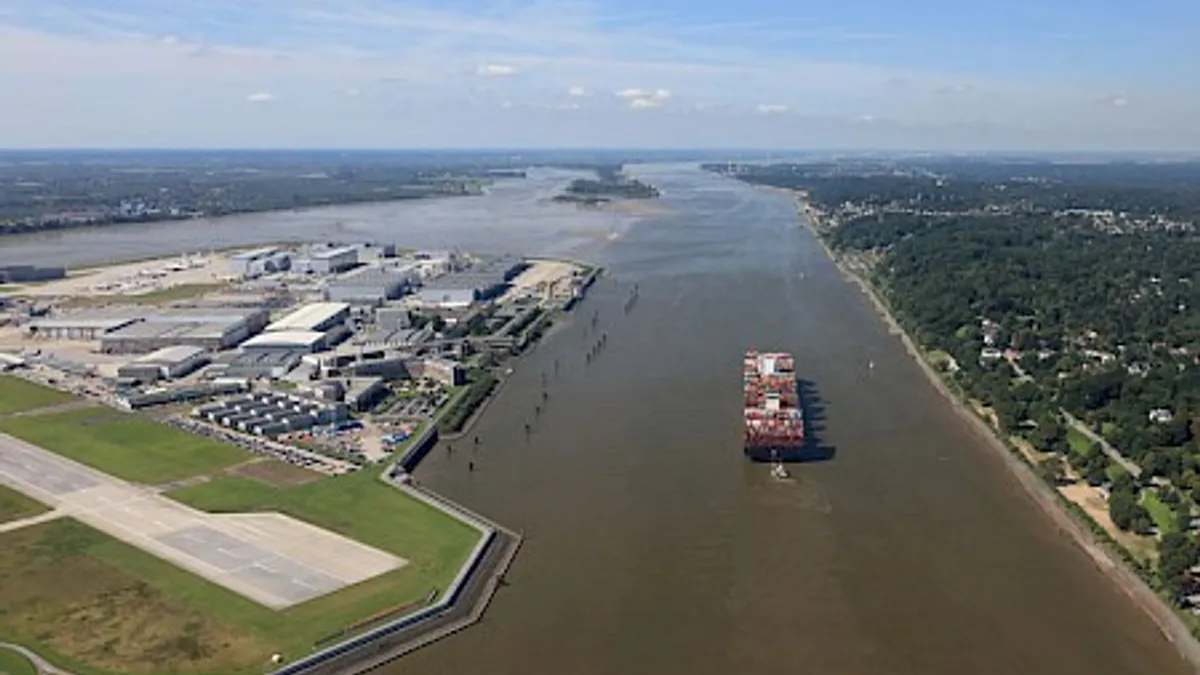Dive Brief:
- Cargo ships flowing between Rotterdam and Hamburg will now be able to adjust their travel speed — and therefore fuel consumption — based on real-time arrival and departure times, thanks to a new deal signed between port facilities in the two cities.
- The Hamburg Vessel Coordination Center (HVCC) and the Rotterdam Port Authority began to pilot a singular digital interface that would allow data exchange between the two facilities at the start of 2018. Last week, the facilities announced the interface was functional.
- Hamburg and Rotterdam are only 24 hours apart by sea, making the availability of real-time data pivotal. As an example, an 18,000 TEU ship making the journey could save 22 tons of bunker fuel and 66 tons of carbon dioxide emissions if it knew to travel at 14 knots (rather than its average of 18 knots) based on terminal queue data.
Dive Insight:
On the surface, the joint initiative is a way to improve terminal and vessel operation efficiency between two ports. But the initiative has the potential to be transformative for supply chains.
"The direct exchange of data between Hamburg and Rotterdam is the logical first step towards building a network of ports all over Europe, particularly in order to increase the ability to react to delays – and thus provide both shipping companies and terminals with improved and reliable support for the arrival and dispatching of ships," Gerald Hirt, managing director of HVCC said in a statement.
In the press release, Hirt invited all other ports to join in the digital interface, hoping to kickstart what has long been a critical need for global supply chains: real-time visibility into port operations.
To date, no national or international system exists that provides shippers, logistics providers and carriers alike the information necessary to see or anticipate delays at ports before their product arrives. Many solutions exist: tracking truck turn times, specific vessels, or self-reported port data, but few are integrated.
The reasons for a lack of an integrated system are many — simply put, the amount of actors needed to invest and collaborate for such a portal to work is a great number — but the effect has been singular: shippers are often caught with the short end of the straw when, inevitably, a disruption does occur.
[This] is the logical first step towards building a network of ports all over Europe.

Gerald Hirt
Managing Director, The Hamburg Vessel Coordination Center
"To the concern of many, the international freight delivery system for U.S. exports and imports strains against the current demands placed upon it," writes Federal Maritime Commissioner Rebecca Dye, in her report on supply chain innovation initiatives from December 2017. "Even single events, such as a storm or a labor dispute that impacts one node in the supply chain, can have systemic consequences that impose significant costs on the U.S. economy."
In the U.S., the ports in Los Angeles and Long Beach are experimenting with a similar portal that addresses the visibility problem iconically singled out in the supply chain innovation report. Increasing visibility, the report finds, "is the process innovation that would provide the greatest improvement ot performance of the American international supply chain."
Otherwise, "supply chain actors are flying blind."
Now in Europe, the ports of Hamburg and Rotterdam — often considered two of the "smartest" facilities in the continent — are making visibility a reality.
In part, that was thanks to the development of The HVCC Hamburg Vessel Coordination Center, a joint venture between two of the German port's terminals. As of June 2017, the facility announced it would make port digitalization a focus point. And only in January of 2018 did IBM partner with the Port of Rotterdam to install the sensors and artificial intelligence infrastructure to make real-time data possible.
Both the U.S. and European projects are in their early stages. But early stages are better than naught, and — if calls to action work — may soon lead to their expansion to other regional ports.














